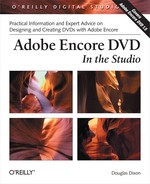We’ve finally come to the actual goal of all this work designing DVDs—building and burning the final result to disc. In the preceding chapters, we used Adobe Encore DVD to import and organize our assets, design the menus to access them, and then linked these elements all together into the navigational flow. And, in Chapter 7, we used the Preview and Check Project functions to verify the design and links in the DVD. So, now we’re all set, and it’s time to burn, right?
Well, not quite. We still need to build the DVD data ready to burn to disc, and, before that, we need to transcode (compress) the video and audio assets into DVD-compatible format. As you know, Encore includes integrated video and audio transcoding, and provides a great deal of flexibility in transcoding and burning your project. Encore can automatically transcode your clips to best fit the size of your project, or you can explicitly specify compression parameters in great detail. It can do the transcoding in the background as you work, or you can schedule the processing when you want it.
Once the transcoding is complete, you can burn your project directly to a DVD disc, or build a DVD folder on hard disk to preview and test. You also can build a disc image of the DVD to simplify burning multiple copies, and even write a DVD master to tape for professional replication, including setting copy protection options.
In this chapter, we’ll step through this process, starting with the quick and easy way, using Encore’s automatic transcoding to build and burn a DVD. Then, we’ll go back and dig into the detailed options for video and audio compression. Finally, we’ll go through each option you can employ when using Encore to build a DVD.
To review the transcode settings for the video and audio clips that you imported into your project, just look at the Project window (shown in Figure 8-1). You also can view the Asset Properties dialog for an individual clip or group of clips.
Figure 8-1. The Encore Project window shows the transcode status of each asset imported into the project.
In this example, the Transcode Status column shows that our AVI video and WAV audio clips are Untranscoded, and the Transcode Settings column is set to Automatic. Any MPEG video clips that are already DVD-compliant are set to Don’t Transcode. Other kinds of Encore objects such as menus and timelines are marked with dashes and N/A for not applicable. If you were to build your project at this point, Encore would choose appropriate compression settings for your clips so that they are compressed at the best quality that will allow your entire project to fit on a DVD disc.
Transcoding video clips takes significant processing time, however—roughly a small multiple of the length of the clip (i.e., around two to three minutes per minute of video), depending on the desired quality and the power of your computer. So, you will save time if you transcode as you work, instead of waiting until you have finished your authoring and are ready to go ahead and build the final DVD.
Once you have imported all the clips into your project, but even before you have finished editing the menus and navigation, you (and Encore) have enough information about the total length of the clips in your project to estimate the appropriate compression parameters to fit all that material on a DVD disc. As a result, you can begin transcoding whenever it’s convenient for you—in the background as you work, or whenever you are going to be away from your machine for an extended period. (After all, it would be a shame to let all those idle processor cycles go to waste!)
To start transcoding a clip or group of clips, select the asset filenames in the Project tab (be sure to choose the clip, and not an associated timeline), and choose File → Transcode → Transcode Now (or choose it from the right-click pop-up context menu). Encore displays the Transcode Progress window as it steps through compressing each clip with its corresponding transcoding settings. The Transcode Progress window is shown in Figure 8-2.
Figure 8-2. The Transcode Progress window displays the progress as each selected clip is transcoded.
Encore performs the video and audio transcoding in the background, as you work. If you select several files to be transcoded, or specify that additional files should be transcoded, the Transcode Progress window shows the queue of clips waiting to be processed.
Encore also updates the Transcode Status column in the Project window as clips are being processed in the background. The status can change from Untranscoded, to Queued (in the Transcode Progress window), to Transcoding Now, and finally to Transcoded. See Figure 8-3. You also may want to resize or reorder the columns (by dragging the headings), or use the right-click Columns menu to display more information.
Even without explicitly setting detailed transcoding options for your clips, as described below, you also can set the default audio format used for automatic transcoding. Choose Edit → Preferences → Encoding to display the Preferences dialog (see Figure 8-4).
Select the default audio encoding format from the drop-down menu (see the section “Audio transcoding settings,” later in this chapter). The best default for most purposes is Dolby Digital (AC-3), which provides good quality audio that is also compressed, and therefore provides additional space on the disc for more content.




